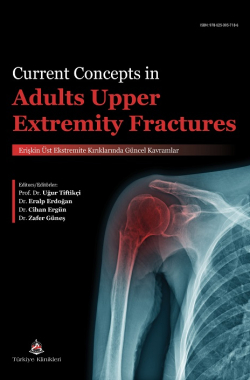HUMERAL SHAFT AND DISTAL FRACTURES: ANATOMY EPIDEMIOLOGY AND CLASSIFICATION OF DIAPHYSEAL FRACTURES
Emin Kürşat Bulut
Niğde Ömer Halisdemı̇ r University, Faculty of Medicine, Department of Orthopedics and Traumatology, Niğde, Türkiye
Bulut EK. Humeral Shaft and Distal Fractures: Anatomy Epidemiology and Classification of Diaphyseal Fr. In: Tiftikçi U, Erdoğan E, Ergün C, Güneş Z, editors. Current Concepts in Adults Upper Extremity Fractures. 1st ed. Ankara: Türkiye Klinikleri; 2025. p.85-89.
ABSTRACT
The humeral shaft consists of the surgical neck in the proximal and the space between the epicondyles in the distal. Its blood supply is heterogeneous, the distal part is less vascularized and the rate of nonunion is high. The main structure responsible for the nutrition of the humeral shaft is the attachment site of the coracobrachialis muscle and the feeding artery in the bone region where the brachialis muscle begins. The deltoid tuberosity and the radial groove are surgically important. The radial nerve passes through the radial groove together with the profunda artery. In the surgical examination of the humeral shaft, the brachial artery, axillary nerve, median, ulnar and radial nerves should be monitored. The Orthopedic Trauma Association (OTA)/AO classification, based on the Müller AO classification of long bone fractures, is the most widely used classification for humeral shaft fractures. Simple, wedge and complex fractures are the three main categories, which are further subdivided according to the fracture pattern.
Keywords: Humerus shaft anatomy; Humerus shaft fractures; Humerus shaft fracture classification; Fracture classification
Kaynak Göster
Referanslar
- Updegrove GF, Mourad W, Abboud JA. Humeral shaft fractures. Journal of shoulder and elbow surgery 2018;27:e87-e97. [Crossref] [PubMed]
- Smolle MA, Bösmüller S, Puchwein P, Ornig M, Leithner A, Seibert F-J. Complications in humeral shaft fractures- non-union, iatrogenic radial nerve palsy, and postoperative infection: a systematic review and meta-analysis. EFORT open reviews 2022;7:95-108. [Crossref] [PubMed] [PMC]
- Pidhorz L. Acute and chronic humeral shaft fractures in adults. Orthopaedics & Traumatology: Surgery & Research 2015;101:S41-S9. [Crossref] [PubMed]
- Zlotolow DA, Catalano III LW, Barron AO, Glickel SZ. Surgical exposures of the humerus. JAAOS-Journal of the American Academy of Orthopaedic Surgeons 2006;14:754-65. [Crossref] [PubMed]
- Jawa A, McCarty P, Doornberg J, Harris M, Ring D. Extra-articular distal-third diaphyseal fractures of the hu merus: a comparison of functional bracing and plate fixation. JBJS 2006;88:2343-7. [Crossref] [PubMed]
- Benegas E, Neto AAF, Neto RB, de Santis Prada F, Malavolta EA, Marchitto GO. Humeral shaft fractures. Revista Brasileira de Ortopedia (English Edition) 2010;45:12-6. [Crossref]
- Walker M, Palumbo B, Badman B, Brooks J, Van Gelderen J, Mighell M. Humeral shaft fractures: a review. Journal of shoulder and elbow surgery 2011;20:833-44. [Crossref] [PubMed]
- Gallusser N, Barimani B, Vauclair F. Humeral shaft fractures. EFORT Open Reviews 2021;6:24-34. [Crossref] [PubMed] [PMC]
- Bounds EJ, Frane N, Jajou L, Weishuhn LJ, Kok SJ. Humeral Shaft Fractures. StatPearls. Treasure Island (FL): StatPearls Publishing Copyright © 2025, StatPearls Publishing LLC.; 2025.

